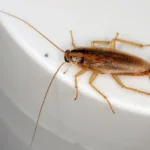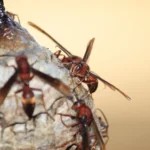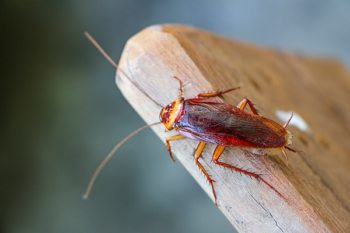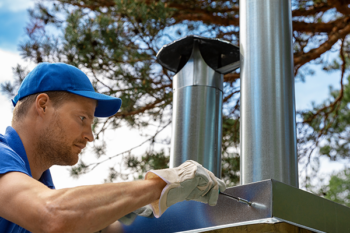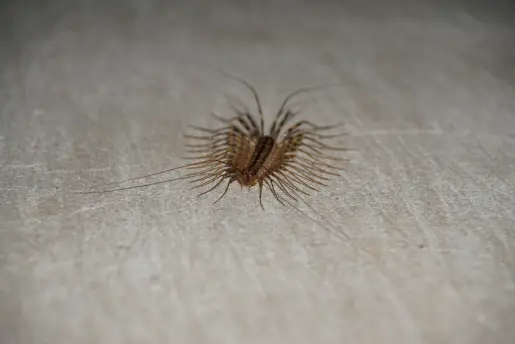
With their many legs and rapid movements, house centipedes (Scutigera coleoptrata) tend to startle anyone who spots them. Although they aren’t harmful to humans, their sudden appearances can be unsettling. If you’ve noticed one racing across the floor, you’re probably wondering what led it inside and why it chose your home of all places.
The reason is pretty straightforward: house centipedes are looking for shelter, moisture, and a steady food supply. If your home checks all those boxes, it becomes an ideal environment.
One Tiny Opening is All it Takes
These insects don’t need a wide opening to get indoors. Their slim, flexible bodies and quick reflexes help them slip through narrow spaces with ease. Cracks in the foundation, gaps around utility lines, uncovered vents, loose exterior siding, and worn-out window seals are all common entry points. Once they’re inside, they gravitate toward cool, dark corners that offer protection and access to food.
Because they’re nocturnal, house centipedes typically stay out of sight during the day. If you spot one, chances are it’s been hiding in the basement, under sinks, or behind large appliances for a while.
They’re Chasing Their Next Meal
These pests usually prefer to remain outdoors, hiding in shady, damp places like mulch beds or piles of leaves. But when their usual prey becomes scarce or begins creeping toward your house, centipedes follow. While they do help reduce populations of unwanted bugs, repeated sightings inside suggest that a pest infestation is keeping them there.
House centipedes hunt and eat a range of indoor pests, such as:
- Ants
- Bed bugs
- Cockroaches
- Crickets
- Earwigs
- Moths
- Silverfish
- Spiders
- Termites
- And many more
Humidity Keeps Them Comfortable
Like many of their arthropod relatives, house centipedes need moisture to stay alive. Outside, they gravitate toward damp mulch, rotting logs, and compost. Inside, they prefer rooms with lingering humidity, such as steamy bathrooms, damp basements, and laundry areas with poor ventilation. Lowering the moisture levels indoors can help make your home less appealing.
Here are a few ways to tackle excess dampness:
- Fix any outdoor leaks or dripping hoses
- Clean gutters and make sure downspouts guide water away from the structure
- Trim thick plants to help the soil dry faster
- Use dehumidifiers in crawl spaces or basements
- Ventilate bathrooms and laundry areas to improve airflow
Clutter Creates Hiding Spots for Centipedes
Dark, quiet spaces make perfect hiding spots for these fast-moving pests. Outdoors, they prefer to shelter under yard debris or in messy storage sheds. Inside, cluttered corners and unused items can give them a hiding spot to rest until nightfall.
You can eliminate their hiding places by:
- Stacking firewood neatly and lifting it off the ground
- Storing outdoor tools and pots in closed sheds or containers
- Bringing patio items indoors when not in use
- Clearing leaf piles and other plant matter regularly
- Keeping your yard trimmed and your lawn mowed
- Sealing cracks around windows, doors, and along the home’s base
- Repairing screens and replacing old or damaged weather stripping
House Centipedes Start Their Journey Outside
You may have seen one racing across your bathroom or disappearing into a drain, but house centipedes don’t originate indoors. These fast-legged arthropods typically begin life outside in damp, shaded environments that provide cover and plenty of bugs to hunt. You’ll often find them hiding beneath soggy leaf piles, decomposing wood, garden mulch, or tucked under landscaping stones and bricks.
One of their favorite spots is the damp soil around your home’s foundation. This zone tends to stay humid and cool, while offering a constant supply of insects. Once centipedes settle into this space, it only takes a stretch of dry weather or a spike in temperature to push them indoors.
To keep them from sneaking in, pay attention to these outdoor hotspots:
- Garden beds and decorative plants: These areas often host aphids, mites, and other prey that attract centipedes.
- Paved surfaces and landscaping features: Pavers and bricks create ideal hiding places for insects and, in turn, their predators.
- Poorly sealed trash bins: Rotting waste draws bugs, which eventually bring hungry centipedes along with them.
A messy or waterlogged yard doesn’t just encourage insect activity, it invites the creatures that feed on them too.
Are House Centipedes a Cause for Concern?
Their sudden sprints and many legs may be unnerving, but house centipedes usually keep to themselves. They aren’t aggressive and will typically flee if spotted. Most of the time, they’re only indoors because they’re chasing a food source, not because they want to interact with people.
Still, it’s not a good idea to handle one. Although their venom is meant for insects, a startled centipede might pinch with its front legs. This bite is generally brief, comparable to a bee sting, but can be uncomfortable.
For individuals with allergies to insect venom, a centipede bite could lead to more serious symptoms such as swelling, dizziness, or difficulty breathing. In such cases, immediate medical attention is necessary.
While these creatures are usually harmless to people, it’s wise to keep children and pets from engaging with them.
How to Recognize a House Centipede
If you’ve seen a strange bug and aren’t sure what it was, a house centipede has some distinct features that can help you identify it:
- Legs: Thin and delicate, their legs fan out like those of a spider, giving them a wispy appearance.
- Quantity of legs: They have 15 pairs, which helps them move quickly, but doesn’t make them the biggest centipede species.
- Speed: These pests are impressively fast, capable of covering more than a foot in just a couple of seconds.
- Coloring: Their bodies are typically pale grayish-yellow with three dark lines running lengthwise down their back.
- Antennae: Long and fine, used to sense their surroundings and navigate in the dark.
- Behavior: Skittish and non-aggressive, they prefer escaping over confrontation.
- Venom: Strong enough for their prey, but only causes minor discomfort in most human interactions.
One Centipede Might Point to a Bigger Pest Problem
Seeing a lone house centipede doesn’t mean your home is infested with them, but it can signal a deeper issue. These predators only stay where food is plentiful. So, if you’re seeing them regularly, it probably means other pests are already living in your walls, basement, or crawlspaces.
Killing one centipede won’t solve the root of the issue. To truly keep them away, you’ll need to address whatever is drawing them indoors.
That’s where Griffin Pest Solutions can help. Our experienced team will inspect your property, identify signs of pest activity, and develop a tailored plan to eliminate both house centipedes and the bugs they’re preying on.
Schedule your inspection today and take the first step toward a pest-free home.

